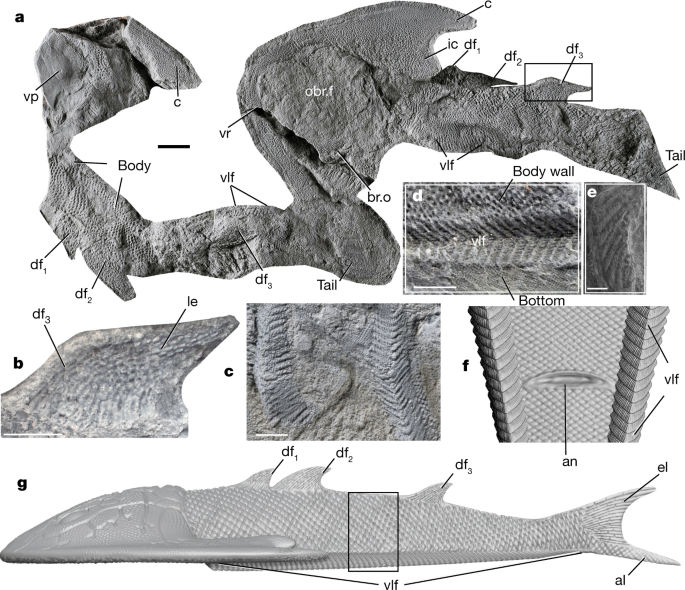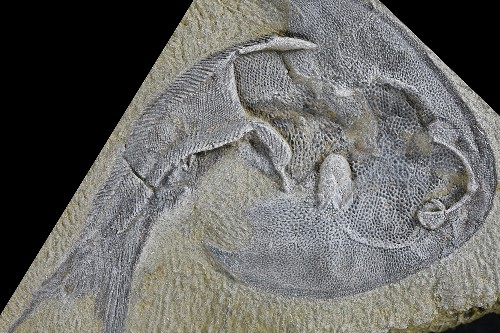Paleontologists have examined the fossilized remains of Tujiaaspis vividus, a species of galeaspid that lived 436 million years ago (Silurian period) in China.

Life reconstructions of Tujiaaspis vividus. Image credit: Qiuyang Zheng.
Theories abound on the evolutionary beginnings of vertebrate fins and limbs — the evolutionary precursors of arms and legs — mostly based on comparative embryology.
There is a rich fossil record, but early vertebrates either had fins or they didn’t. There was little evidence for their gradual evolution.
“Galeaspids are an extinct group of jawless vertebrates — members of a paraphyletic array of extinct stem gnathostomes that are more closely related to living jawed vertebrates than to lampreys and hagfishes,” said University of Bristol researcher Zhikun Gai and colleagues.
“As such, they provide key insights into the evolutionary assembly of the gnathostome body plan, including the profound reorganization of the vertebrate skull that occurred before the origin of jaws.”
“Unfortunately, knowledge of the anatomy of galeaspids has been limited almost exclusively to their headshields; the few incomplete fragments of trunk skeletons that have been discovered provide little insight into the nature of their appendicular skeleton.”
“Therefore, scenarios for the origin and evolution of paired and unpaired fins remain contingent on discovery of the condition in galeaspids.”

Photograph (a) and interpretative drawing (b) of Tujiaaspis vividus. Image credit: Gai et al., doi: 10.1038/s41586-022-04897-6.
The new fossils of Tujiaaspis vividus from the Silurian period of China contain their whole bodies.
“The new fossils are spectacular, preserving the whole body for the first time and revealing that these animals possessed paired fins that extended continuously, all the way from the back of the head to the very tip of the tail,” Gai said.
“This is a great surprise since galeaspids have been thought to lack paired fins altogether.”
“Tujiaaspis vividus breathes new life into a century old hypothesis for the evolution of paired fins, through differentiation of pectoral (arms) and pelvic (legs) fins over evolutionary time from a continuous head-to-tail fin precursor,” said University of Bristol’s Professor Philip Donoghue.
“This ‘fin-fold’ hypothesis has been very popular but it has lacked any supporting evidence until now.”

“The discovery of Tujiaaspis vividus resurrects the fin-fold hypothesis and reconciles it with contemporary data on the genetic controls on the embryonic development of fins in living vertebrates.”
“Tujiaaspis vividus shows the primitive condition for paired fins first evolved,” said Dr. Min Zhu, a researcher in the Institute of Vertebrate Paleontology and Paleoanthropology at the Chinese Academy of Sciences.
“Later groups, like the jawless osteostracans show the first evidence for the separation of muscular pectoral fins, retaining long pelvic fins that reduced to the short muscular fins in jawed vertebrates, such as in groups like placoderms and sharks.”
“Nevertheless, we can see vestiges of elongate fin-folds in the embryos of living jawed fishes, which can be experimentally manipulated to reproduce them. The key question is why did fins first evolve in this way?”

The scientists also simulate the behavior of models of Tujiaaspis vividus with and without the paired fins.
“The paired fins of Tujiaaspis vividus act as hydrofoils, passively generating lift for the fish without any muscular input from the fins themselves,” said Dr. Humberto Ferron, a researcher at the University of Bristol.
“The lateral fin-folds of Tujiaaspis vividus allowed it to swim more efficiently.”
“Fossil jawless vertebrates display a dizzying array of fin types, which has provoked extensive debate about the evolution of paired fins,” said Dr. Joseph Keating, also from the University of Bristol.
“Our new analyses suggest that the ancestor of jawed vertebrates likely possessed paired fin-folds, which became separated into pectoral and pelvic regions.”
“Eventually, these primitive fins evolved musculature and skeletal support, which allowed our fishy ancestors to better steer their swimming and add propulsion.”
“It is amazing to think that the evolutionary innovations seen in Tujiaaspis vividus underpin locomotion in animals as diverse as birds, whales, bats and humans.”
Source: sci.news





